Received this in an email from old army mate Stoney B. I couldn’t find a link so have included the entire text for the interest of readers and also in the interest of winding up any peaceniks who might accidently arrive on my site.
Boeing’s new laser cannon can melt a hole in a tank from five miles away and 10,000 feet up-and it’s ready to fly this year
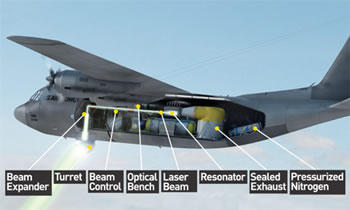
Creating a laser that can melt a soda can in a lab is a finicky enough task. Later this year, scientists will put a 40,000-pound chemical laser in the belly of a gunship flying at 300 mph and take aim at targets as far away as five miles. And we’re not talking aluminum cans. Boeing’s new Advanced Tactical Laser will cook trucks, tanks, radio stations-the kinds of things hit with missiles and rockets today. Whereas conventional projectiles can lose sight of their target and be shot down or deflected, the ATL moves at the speed of light and can strike several targets in rapid succession.
Last December, Boeing, under contract from the Department of Defense, installed a $200-million prototype of the laser into a C-130 at Kirtland Air Force Base in New Mexico in preparation for test flights this year. From there it will go to the Air Force for more testing, and it could be in battle within five years.
Precise control over the beam’s aim allows it to hit a moving target a few inches wide and confine the damage to that space. The Pentagon hopes such precision will translate into less collateral damage than even today’s most accurate missiles. Future versions using different types of lasers could be mounted on smaller vehicles, such as fighter jets, helicopters and trucks.
How to Melt a Tank in Three Seconds Or Less
1. Find Your Target
When the C-130 flies within targeting range (up to five miles away), the gunner aims using a rotating video camera mounted beneath the fuselage. The computer locks onto the object to continually track it. A second crew member precisely adjusts the laser beam’s strength -higher power to disable vehicles, lower power to knock out, say, a small power generator. The gunner hits ‘fire,’ and the computer takes over from there.
2. Heat Up the Laser
In a fraction of a second, chlorine gas mixes with hydrogen peroxide. The resulting chemical reaction creates highly energetic oxygen molecules. Pressurized nitrogen pushes the oxygen through a fine mist of iodine, transferring the oxygen’s energy to iodine molecules, which shed it in the form of intense light.
3. Amplify the Beam
The optical resonator bounces this light between mirrors, forcing more iodine molecules to cough up their photons, further increasing the laser beam’s intensity. From there, the light travels through a sealed pipe above the weapon’s crew station and into a chamber called the optical bench. There, sensors determine the beam’s quality, while mechanically controlled mirrors compensate for movement of the airplane, vibration and atmospheric conditions. Precise airflow regulates the chamber’s temperature and humidity, which helps keep the beam strong.
4. Stand Clear
A kind of reverse telescope called the beam expander inside a retractable, swiveling pod called the turret widens the beam to 20 inches and aims it. The laser’s computer determines the distance to the target and adjusts the beam so it condenses into a focused point at just the right spot. Tracking computers help make microscopic adjustments to compensate for both the airplane’s and the target’s movement. A burst of a few seconds’ duration will burn a several-inch-wide hole in whatever it hits.
F A Q
•
How hot is the beam? The laser itself isn’t hot, but it can heat its target to thousands of degrees.
•
Does the laser sear everything in its path? Yes If a bird flew into the firing laser’s line of sight-
well, no more bird. Fortunately, the weapon will fire for only a few seconds at a time, minimizing the risk.
•
Does it melt its target or just set it aflame? That depends on what it hits. It will melt metal, but if the target is combustible, it will burn.
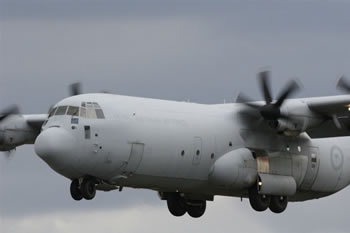 This weekend the Royal Australian Air Force will celebrate fifty years of outstanding achievements by its enduring ‘work horse’ – the C-130 Hercules aircraft.
I flew on all variants from the old A model in 1964 through to the J model in the mid 80s and appreciated their capabilities. I spent some time as Unit Emplaning officer of 1RAR in the ODF in Townsville and was forced by appointment to become precisely knowledgeable of their capability to manage the deployment of a Battalion group on Ex Swift Eagle. They have been a great asset to the military and will be for some to come.
Chief of Air Force, Air Marshal Mark Binskin says;
This weekend the Royal Australian Air Force will celebrate fifty years of outstanding achievements by its enduring ‘work horse’ – the C-130 Hercules aircraft.
I flew on all variants from the old A model in 1964 through to the J model in the mid 80s and appreciated their capabilities. I spent some time as Unit Emplaning officer of 1RAR in the ODF in Townsville and was forced by appointment to become precisely knowledgeable of their capability to manage the deployment of a Battalion group on Ex Swift Eagle. They have been a great asset to the military and will be for some to come.
Chief of Air Force, Air Marshal Mark Binskin says;
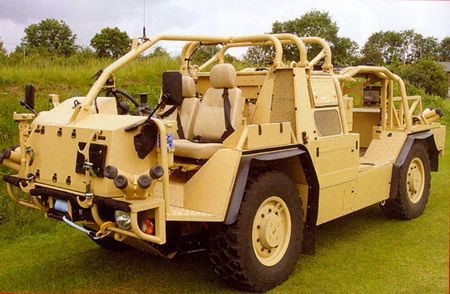 I doubt the SASR will use them in yellow livery but this is the vehicle ordered
1200 new Mercede Benz Gelaendenwagens (G-Wagons) are also coming on line.
I doubt the SASR will use them in yellow livery but this is the vehicle ordered
1200 new Mercede Benz Gelaendenwagens (G-Wagons) are also coming on line.
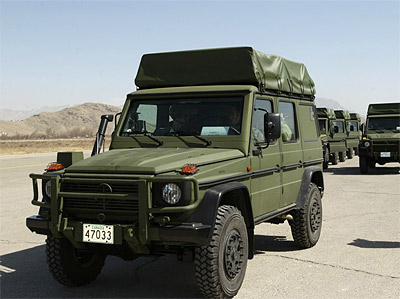 The pic is of the Canadian G-Wagon stolen from
The pic is of the Canadian G-Wagon stolen from 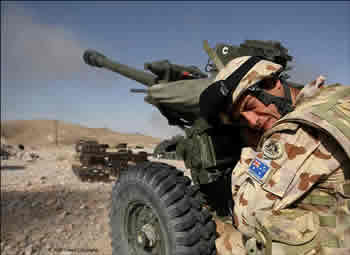 Haven’t been to Michael Yon’s site for a month or two but visited today and found great reading on Afghanistan He is with the Brit’s 2nd Para and writes of their day to day life fighting “Terry” Taliban (as the Brits call them). If you read on you will find some mention of us Aussies but only a passing reference.
I would really like to see an Australian journalist submit reports on Australian operations with the personal detail Yon uses when reporting on the Brits and the Yanks. It has long been a complaint of mine that the Australian military Public Relations people are more reactive than proactive. I’m sure Australians would love to read of the daily struggles and successes of our troops in far off lands written in a positive style; to read of their sons and daughters lives as they play their part in the war.
Surely it’s a strategy of war to keep the public at home informed and yet all I ever read is terse military media emails that read just like the reports I used to write – just the facts man, just the facts. Minister for Defence said in Canberra today…….Chief of Navy says recruiting up….Gen Gillespie reports troops involved in clash… boring…boring.
Come on guys, give us something to hang on to.
Whatever, go read how
Haven’t been to Michael Yon’s site for a month or two but visited today and found great reading on Afghanistan He is with the Brit’s 2nd Para and writes of their day to day life fighting “Terry” Taliban (as the Brits call them). If you read on you will find some mention of us Aussies but only a passing reference.
I would really like to see an Australian journalist submit reports on Australian operations with the personal detail Yon uses when reporting on the Brits and the Yanks. It has long been a complaint of mine that the Australian military Public Relations people are more reactive than proactive. I’m sure Australians would love to read of the daily struggles and successes of our troops in far off lands written in a positive style; to read of their sons and daughters lives as they play their part in the war.
Surely it’s a strategy of war to keep the public at home informed and yet all I ever read is terse military media emails that read just like the reports I used to write – just the facts man, just the facts. Minister for Defence said in Canberra today…….Chief of Navy says recruiting up….Gen Gillespie reports troops involved in clash… boring…boring.
Come on guys, give us something to hang on to.
Whatever, go read how  Creating a laser that can melt a soda can in a lab is a finicky enough task. Later this year, scientists will put a 40,000-pound chemical laser in the belly of a gunship flying at 300 mph and take aim at targets as far away as five miles. And we’re not talking aluminum cans. Boeing’s new Advanced Tactical Laser will cook trucks, tanks, radio stations-the kinds of things hit with missiles and rockets today. Whereas conventional projectiles can lose sight of their target and be shot down or deflected, the ATL moves at the speed of light and can strike several targets in rapid succession.
Last December, Boeing, under contract from the Department of Defense, installed a $200-million prototype of the laser into a C-130 at Kirtland Air Force Base in New Mexico in preparation for test flights this year. From there it will go to the Air Force for more testing, and it could be in battle within five years.
Precise control over the beam’s aim allows it to hit a moving target a few inches wide and confine the damage to that space. The Pentagon hopes such precision will translate into less collateral damage than even today’s most accurate missiles. Future versions using different types of lasers could be mounted on smaller vehicles, such as fighter jets, helicopters and trucks.
How to Melt a Tank in Three Seconds Or Less
1. Find Your Target
When the C-130 flies within targeting range (up to five miles away), the gunner aims using a rotating video camera mounted beneath the fuselage. The computer locks onto the object to continually track it. A second crew member precisely adjusts the laser beam’s strength -higher power to disable vehicles, lower power to knock out, say, a small power generator. The gunner hits ‘fire,’ and the computer takes over from there.
2. Heat Up the Laser
In a fraction of a second, chlorine gas mixes with hydrogen peroxide. The resulting chemical reaction creates highly energetic oxygen molecules. Pressurized nitrogen pushes the oxygen through a fine mist of iodine, transferring the oxygen’s energy to iodine molecules, which shed it in the form of intense light.
3. Amplify the Beam
The optical resonator bounces this light between mirrors, forcing more iodine molecules to cough up their photons, further increasing the laser beam’s intensity. From there, the light travels through a sealed pipe above the weapon’s crew station and into a chamber called the optical bench. There, sensors determine the beam’s quality, while mechanically controlled mirrors compensate for movement of the airplane, vibration and atmospheric conditions. Precise airflow regulates the chamber’s temperature and humidity, which helps keep the beam strong.
4. Stand Clear
A kind of reverse telescope called the beam expander inside a retractable, swiveling pod called the turret widens the beam to 20 inches and aims it. The laser’s computer determines the distance to the target and adjusts the beam so it condenses into a focused point at just the right spot. Tracking computers help make microscopic adjustments to compensate for both the airplane’s and the target’s movement. A burst of a few seconds’ duration will burn a several-inch-wide hole in whatever it hits.
F A Q
• How hot is the beam? The laser itself isn’t hot, but it can heat its target to thousands of degrees.
• Does the laser sear everything in its path? Yes If a bird flew into the firing laser’s line of sight-
well, no more bird. Fortunately, the weapon will fire for only a few seconds at a time, minimizing the risk.
• Does it melt its target or just set it aflame? That depends on what it hits. It will melt metal, but if the target is combustible, it will burn.
Creating a laser that can melt a soda can in a lab is a finicky enough task. Later this year, scientists will put a 40,000-pound chemical laser in the belly of a gunship flying at 300 mph and take aim at targets as far away as five miles. And we’re not talking aluminum cans. Boeing’s new Advanced Tactical Laser will cook trucks, tanks, radio stations-the kinds of things hit with missiles and rockets today. Whereas conventional projectiles can lose sight of their target and be shot down or deflected, the ATL moves at the speed of light and can strike several targets in rapid succession.
Last December, Boeing, under contract from the Department of Defense, installed a $200-million prototype of the laser into a C-130 at Kirtland Air Force Base in New Mexico in preparation for test flights this year. From there it will go to the Air Force for more testing, and it could be in battle within five years.
Precise control over the beam’s aim allows it to hit a moving target a few inches wide and confine the damage to that space. The Pentagon hopes such precision will translate into less collateral damage than even today’s most accurate missiles. Future versions using different types of lasers could be mounted on smaller vehicles, such as fighter jets, helicopters and trucks.
How to Melt a Tank in Three Seconds Or Less
1. Find Your Target
When the C-130 flies within targeting range (up to five miles away), the gunner aims using a rotating video camera mounted beneath the fuselage. The computer locks onto the object to continually track it. A second crew member precisely adjusts the laser beam’s strength -higher power to disable vehicles, lower power to knock out, say, a small power generator. The gunner hits ‘fire,’ and the computer takes over from there.
2. Heat Up the Laser
In a fraction of a second, chlorine gas mixes with hydrogen peroxide. The resulting chemical reaction creates highly energetic oxygen molecules. Pressurized nitrogen pushes the oxygen through a fine mist of iodine, transferring the oxygen’s energy to iodine molecules, which shed it in the form of intense light.
3. Amplify the Beam
The optical resonator bounces this light between mirrors, forcing more iodine molecules to cough up their photons, further increasing the laser beam’s intensity. From there, the light travels through a sealed pipe above the weapon’s crew station and into a chamber called the optical bench. There, sensors determine the beam’s quality, while mechanically controlled mirrors compensate for movement of the airplane, vibration and atmospheric conditions. Precise airflow regulates the chamber’s temperature and humidity, which helps keep the beam strong.
4. Stand Clear
A kind of reverse telescope called the beam expander inside a retractable, swiveling pod called the turret widens the beam to 20 inches and aims it. The laser’s computer determines the distance to the target and adjusts the beam so it condenses into a focused point at just the right spot. Tracking computers help make microscopic adjustments to compensate for both the airplane’s and the target’s movement. A burst of a few seconds’ duration will burn a several-inch-wide hole in whatever it hits.
F A Q
• How hot is the beam? The laser itself isn’t hot, but it can heat its target to thousands of degrees.
• Does the laser sear everything in its path? Yes If a bird flew into the firing laser’s line of sight-
well, no more bird. Fortunately, the weapon will fire for only a few seconds at a time, minimizing the risk.
• Does it melt its target or just set it aflame? That depends on what it hits. It will melt metal, but if the target is combustible, it will burn.